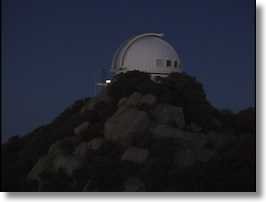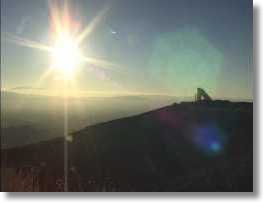|
G e o f f H a i n e s - S t i l e s Project Director PASSPORT TO KNOWLEDGE & the LIVE FROM... specials Friday November 20 "Sunrise...Sunset" on Kitt Peak
We'd been up before dawn, and driven down the windy (and winding) road from Sac. Peak, always alert for some of the monster elk we'd seen in the headlights the night before, and then through Alamagordo to spend some time in the disorienting landscape of White Sands National Monument. It was a pretty gray day, and the gypsum dunes seemed featureless. "Sun over Dunes", the images that were the target of our hunt, was more like a klieg light looming over a sci-fi set. Now, after sunset, we were driving up the final mile or so to Kitt Peak using only parking lights-with sheer drops on either side, we assumed!-so as not to disturb the night-time observers who'd already begun their work. But Jeff Henrikson, who supervises visits to KP, took it pretty carefully-more so than some of the regular denizens of the mountain we later met, who'd obviously been practicing snappy vehicular maneuvers in the dark for some time! We were issued flashlights, beams blinkered in thick red plastic, checked out our modest but very comfortable rooms-each equipped with an impermeable blackout roller blind-and grabbed a sandwich from the supply left by the cooks when they departed at 18:00 hours. If an astronomer wanted cheese-stuffed shells at 2:00 a.m., or fruit or cookies, they'd be in luck! Then Jeff took us for a quick orientation walk around the mountain. It was a cold, clear night, and even the gigantic dome of the 4 meter (158") Mayall Telescope took a back seat to the Milky Way. We could see the glow of Tucson, and even Phoenix, further off, but mostly it was the dark silhouettes of the 20 or so telescopes (there are 24 in total, but the solar 'scopes were asleep for the night), occasional whirs and hums and clanks as the telescopes themselves were repositioned, but mostly-silence. We spotted a couple of places which Jeff assured us would be good for sunrise shots, and turned in. Saturday November 21
One of the great things about working in TV is that the job impels you to do things you'd otherwise miss out on. Film and video folks speak about "magic hour"-the time of day when sunrise and sunset transform the workaday world into something out of the ordinary (rather as Von Del Chamberlain does in Chapter 4 of the LIVE FROM THE SUN Factbook.) So here we were, grabbing coffee re-heated in the microwave at 05:30 (and a few of those cookies!), and setting up our two tripods in the dark, trying for a shot where the sun would rise above the McMath-Pierce Solar Telescope, the largest solar telescope in the world. One digital camera would be set to create a timelapse sequence, and the other would capture details as dawn washed down over the mountain and the domes, closing up after their full night's work. But with the whole horizon brightening, and no astronomer to guide us, we had to guess a little: looked like that notch in those distant mountains would line up with the rising sun... and it did. The Sun rose, pink light slithered down the white domes, and-in counterpoint-Earth's dark shadow cast on the screen of the sky sank down below the horizon. |

